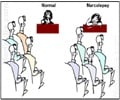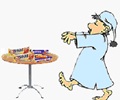A study has revealed that the chances of suffering from obstructive aleep apnea is high among adults with Down syndrome.
A study has revealed that the chances of suffering from obstructive aleep apnea is high among adults with Down syndrome.
However, complications of untreated OSA-such as cardiovascular disease, daytime sleepiness and impaired cognitive functioning-overlap with the manifestations of Down syndrome, which does not allow detection of OSA.The results revealed that 94 percent of subjects with Down syndrome had OSA, 88 percent had at least moderate OSA with an apnea-hypopnea index (AHI) of more than 15 breathing pauses per hour of sleep, and 69 percent had severe OSA with an AHI of more than 30.
Twelve of the 16 subjects with Down syndrome were obese, and there was a significant correlation between body mass index (BMI) and AHI.
Total sleep time in subjects with Down syndrome (307 minutes) was more than an hour less than in controls (380 minutes).
Despite the severity of OSA in the study group, medical evaluation had been sought in only one case.
Senior author Dr. Carole Marcus, at the University of Pennsylvania, said that it is well known that children with Down syndrome are at risk for OSA, with a prevalence of 30 to 55 percent.
Advertisement
"Patients with Down syndrome have a great deal of risk factors for OSA (based on their narrow midface, large tongue, floppy muscle tone, tendency towards being overweight, and thyroid disease). However, the fact that almost all of the subjects studied had OSA was a much higher prevalence than we expected. It was surprising how severe the illness was, and how the OSA was unsuspected by their caregivers," said Marcus.
Advertisement
They found that controls had less severe sleep apnea with a median AHI of 16, 54 percent had an AHI of more than15, and 38 percent had an AHI of more than 30.
The authors have suggested that obesity, a common and potentially treatable problem in Down syndrome, appears to play an important role in the pathophysiology of OSA in this population.
The study has been published in the Journal of Clinical Sleep Medicine.
Source-ANI
SAV















